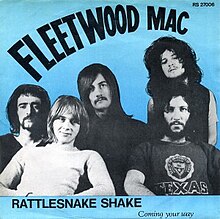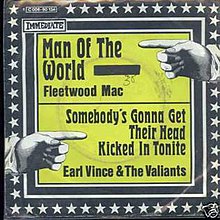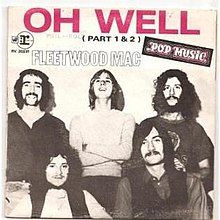Rock and roll music

From Wikipedia, the free encyclopedia
Leer más
Rattlesnake Shake
Fleetwood Mac
Discográfica: Reprise · · Productor: Fleetwood Mac[2]
CHARTS
UK
IRL
|
1
|
Rattlesnake Shake
Fleetwood Mac •
w: Green •
1969 /09
|
3:30 |
|
|
|
2
|
Coming Your Way
Fleetwood Mac •
w: Danny Kirwan •
1969 /09
|
3:47 |
|
Album
Then Play On
Fecha Lanzamiento: 19 Septiembre 1969 · Fecha Grabación: 1968 - 1969Discográfica: Reprise · Estudio de Grabación: CBS and De Lane Lea, London[1] · Productor: Fleetwood Mac
CHARTS
UK
US
GER
NOR
|
1
|
Coming Your Way
Fleetwood Mac •
w: Danny Kirwan •
1969 /09 /19
|
3:47 |
|
|
|
2
|
Closing My Eyes
Fleetwood Mac •
w: Peter Green •
1969 /09 /19
|
4:55 |
|
|
|
3
|
Showbiz Blues
Fleetwood Mac •
w: Green •
1969 /09 /19
|
3:54 |
|
|
|
4
|
My Dream
Fleetwood Mac •
w: Kirwan •
1969 /09 /19
|
3:33 |
|
|
|
5
|
Underway
Fleetwood Mac •
w: Green •
1969 /09 /19
|
2:54 |
|
|
|
6
|
Oh Well
Fleetwood Mac •
w: Green •
1969 /09 /19
|
9:02 |
|
|
|
7
|
Although The Sun Is Shining
Fleetwood Mac •
w: Kirwan •
1969 /09 /19
|
2:25 |
|
|
|
8
|
Rattlesnake Shake
Fleetwood Mac •
w: Green •
1969 /09 /19
|
3:30 |
|
|
|
9
|
Searching For Madge
Fleetwood Mac •
w: John McVie •
1969 /09 /19
|
6:58 |
|
|
|
10
|
Fighting For Madge
Fleetwood Mac •
w: Mick Fleetwood •
1969 /09 /19
|
2:48 |
|
|
|
11
|
When You Say
Fleetwood Mac •
w: Kirwan •
1969 /09 /19
|
4:32 |
|
|
|
12
|
Like Crying Like Dying
Fleetwood Mac •
1969 /09 /19
|
2:24 |
|
|
|
13
|
Before The Beginning
Fleetwood Mac •
w: Green •
1969 /09 /19
|
3:26 |
|
| "Rattlesnake Shake" | |
|---|---|
 | |
| Single by Fleetwood Mac | |
| from the album Then Play On | |
| B-side | "Coming Your Way" |
| Released | September 1969 (US)[1] |
| Recorded | 1969 |
| Genre | Blues rock Psychedelic blues |
| Length | 3:32 |
| Label | Reprise |
| Songwriter(s) | Peter Green |
| Producer(s) | Fleetwood Mac[2] |
Review
From Wikipedia, the free encyclopedia
Leer más
This article is about the Fleetwood Mac song. For the Mötley Crüe song, see Dr. Feelgood (album). For the Skid Row song, see Skid Row (Skid Row album).
1969 single by Fleetwood Mac
"Rattlesnake Shake" is a song by British rock group Fleetwood Mac, written by guitarist Peter Green, which first appeared on the band`s 1969 album Then Play On. The track was one of the band`s crowd-favorites in the late 1960s.[3]
Background
During a 1969 interview with Peter Green prior to the release of Then Play On, Nick Logan of New Musical Express discussed the song`s subject matter as being "about a male function not mentioned in the best circles."[4] Green said in a 1999 Q&A with The Penguin that "Rattlesnake Shake" was about masturbation and reckoned that the lyrical content was inspired by Fleetwood.[5] Mick Fleetwood would later back up this claim in his 2014 autobiography Play On, stating that "Rattlesnake Shake" was an ode to masturbation. "I`m named in it, as a guy who does the rattlesnake shake to jerk away my sadness whenever I don`t have a chick. That was an appropriate immortalisation of my younger self."[6] In 2012, Fleetwood picked "Rattlesnake Shake" as one of his 11 greatest recordings.[7]
To achieve the rustling noises heard at the end of each chorus, Green used the sounds of an actual rattlesnake found on an audio tape.[4][8] According to Fleetwood, the double-time shuffle near the end of the song was an unplanned addition to the song, although the band approved of the section and decided to keep it.[7][9] "It incorporated the freedom to go off on a tangent, to jam. You hear that alive and well in the double-time structure that I put in at the end, which on stage could last half an hour. It was our way of being in the Grateful Dead."[7]
Although "Oh Well" charted in the UK in October 1969, it was not released in the US at the time. Instead, the band`s manager selected "Rattlesnake Shake" to be released in the US as he believed that it would be a successful single.[10] However, "Rattlesnake Shake" did not chart, and "Oh Well" was released as the follow-up single in January 1970, reaching No. 55 on the Billboard Hot 100.[11]
Critical reception
"Rattlesnake Shake" largely received positive reviews from music reviewers. Rolling Stone identified it as a "key track" of Green`s along with "Albatross".[12] Record World described the song as a "rock and roll bouncer" and called the band a "talented" group of English musicians.[13] Writing for AllMusic, Michael G. Nastos characterised the song as "down-and-dirty, even-paced funk, with clean, wall-of-sound guitars."[14] Ultimate Classic Rock placed it at No. 7 on their Top 10 `Peter Green Fleetwood Mac Songs` list.[15] Holly Gleason of Paste ranked the song number No. 19 on their list of the 20 Best Fleetwood Mac Songs; it was one of two Peter Green songs to appear on the list along with "Oh Well".[16]
Track listing
- US Vinyl (Reprise 0860)[13]
- "Rattlesnake Shake"
- "Coming Your Way"
Personnel
Fleetwood Mac
- Peter Green – guitar, vocals
- Danny Kirwan – electric guitar
- John McVie – bass guitar
- Mick Fleetwood – drums
Chart performance
| Chart (1970) | Peak position |
|---|---|
| Netherlands (Dutch Top 40 Tipparade)[17] | 4 |
Cover versions
Mick Fleetwood later covered the song on his debut solo album, The Visitor. Released in 1981, this recording featured choral vocals and tribal percussion.[9] Peter Green, the track`s composer, also contributed guitar and vocals at a recording studio owned by Jimmy Page.[18] During this time, Green had begun to reemerge professionally and released a series of solo albums up through the first half of the decade.[19] The rerecorded 1981 version reached No. 30 on the Mainstream Rock chart.[20]
Also in 1981, Bob Welch recorded a live version of the track on his album Live at The Roxy, with contributions from Stevie Nicks (tambourine), Christine McVie (maracas), Mick Fleetwood (drums), Robbie Patton (cowbell), Alvin Taylor (guitar), Robin Sylvester (bass), Joey Brasler (guitar), and David Adelstein (keyboards). The album was released in 2004.[21]
A 1973 live version of "Rattlesnake Shake" appeared on Aerosmith`s 1991 box set Pandora`s Box.[22] Steven Tyler of Aerosmith recalled that he had seen one of Joe Perry`s bands in the 1960s cover the song, which he partially attributed to their eventual musical partnership.[23] In 2020, Tyler later performed the song live with Fleetwood for a Peter Green tribute concert. A recording from the show later appeared on the Celebrate the Music of Peter Green and the Early Years of Fleetwood Mac live album.[24]
In 2005, former Fleetwood Mac guitarist Rick Vito covered "Rattlesnake Shake" on an album of the same name.[25] The Mick Fleetwood Blues Band recorded a live version of "Rattlesnake Shake" for their album Blue Again! in 2008, which featured Vito on guitar and vocals.[26]
In 2013, the Mick Fleetwood Blues Band played the song at a concert in Hawaii with Christine McVie, who at the time had not been a member of Fleetwood Mac for 15 years. McVie initiated the collaboration by calling Fleetwood, which prompted him and Vito to bring a piano to her hotel suite so she could practice the material. "Rattlesnake Shake" was one of the four songs McVie played with the Mick Fleetwood Blues Band, with the others being "Get Like You Used to Be", "World Turning" and "Don`t Stop.[6]
Personnel (Mick Fleetwood version)
- Peter Green – vocals, lead guitar
- Mick Fleetwood – drums, percussion
- Richard Dashut – percussion
- George Hawkins – bass guitar
- Todd Sharp – guitar
- Lord Tiki – hand drums
- Tony Todaro – percussion
- The Clapettes – percussion
- Ebaali Gbiko – percussion, backing vocals
From Wikipedia, the free encyclopedia
This article is about the Fleetwood Mac song. For the Mötley Crüe song, see Dr. Feelgood (album). For the Skid Row song, see Skid Row (Skid Row album).
1969 single by Fleetwood Mac
"Rattlesnake Shake" is a song by British rock group Fleetwood Mac, written by guitarist Peter Green, which first appeared on the band`s 1969 album Then Play On. The track was one of the band`s crowd-favorites in the late 1960s.[3]
Background
During a 1969 interview with Peter Green prior to the release of Then Play On, Nick Logan of New Musical Express discussed the song`s subject matter as being "about a male function not mentioned in the best circles."[4] Green said in a 1999 Q&A with The Penguin that "Rattlesnake Shake" was about masturbation and reckoned that the lyrical content was inspired by Fleetwood.[5] Mick Fleetwood would later back up this claim in his 2014 autobiography Play On, stating that "Rattlesnake Shake" was an ode to masturbation. "I`m named in it, as a guy who does the rattlesnake shake to jerk away my sadness whenever I don`t have a chick. That was an appropriate immortalisation of my younger self."[6] In 2012, Fleetwood picked "Rattlesnake Shake" as one of his 11 greatest recordings.[7]
To achieve the rustling noises heard at the end of each chorus, Green used the sounds of an actual rattlesnake found on an audio tape.[4][8] According to Fleetwood, the double-time shuffle near the end of the song was an unplanned addition to the song, although the band approved of the section and decided to keep it.[7][9] "It incorporated the freedom to go off on a tangent, to jam. You hear that alive and well in the double-time structure that I put in at the end, which on stage could last half an hour. It was our way of being in the Grateful Dead."[7]
Although "Oh Well" charted in the UK in October 1969, it was not released in the US at the time. Instead, the band`s manager selected "Rattlesnake Shake" to be released in the US as he believed that it would be a successful single.[10] However, "Rattlesnake Shake" did not chart, and "Oh Well" was released as the follow-up single in January 1970, reaching No. 55 on the Billboard Hot 100.[11]
Critical reception
"Rattlesnake Shake" largely received positive reviews from music reviewers. Rolling Stone identified it as a "key track" of Green`s along with "Albatross".[12] Record World described the song as a "rock and roll bouncer" and called the band a "talented" group of English musicians.[13] Writing for AllMusic, Michael G. Nastos characterised the song as "down-and-dirty, even-paced funk, with clean, wall-of-sound guitars."[14] Ultimate Classic Rock placed it at No. 7 on their Top 10 `Peter Green Fleetwood Mac Songs` list.[15] Holly Gleason of Paste ranked the song number No. 19 on their list of the 20 Best Fleetwood Mac Songs; it was one of two Peter Green songs to appear on the list along with "Oh Well".[16]
Track listing
- US Vinyl (Reprise 0860)[13]
- "Rattlesnake Shake"
- "Coming Your Way"
Personnel
Fleetwood Mac
- Peter Green – guitar, vocals
- Danny Kirwan – electric guitar
- John McVie – bass guitar
- Mick Fleetwood – drums
Chart performance
| Chart (1970) | Peak position |
|---|---|
| Netherlands (Dutch Top 40 Tipparade)[17] | 4 |
Cover versions
Mick Fleetwood later covered the song on his debut solo album, The Visitor. Released in 1981, this recording featured choral vocals and tribal percussion.[9] Peter Green, the track`s composer, also contributed guitar and vocals at a recording studio owned by Jimmy Page.[18] During this time, Green had begun to reemerge professionally and released a series of solo albums up through the first half of the decade.[19] The rerecorded 1981 version reached No. 30 on the Mainstream Rock chart.[20]
Also in 1981, Bob Welch recorded a live version of the track on his album Live at The Roxy, with contributions from Stevie Nicks (tambourine), Christine McVie (maracas), Mick Fleetwood (drums), Robbie Patton (cowbell), Alvin Taylor (guitar), Robin Sylvester (bass), Joey Brasler (guitar), and David Adelstein (keyboards). The album was released in 2004.[21]
A 1973 live version of "Rattlesnake Shake" appeared on Aerosmith`s 1991 box set Pandora`s Box.[22] Steven Tyler of Aerosmith recalled that he had seen one of Joe Perry`s bands in the 1960s cover the song, which he partially attributed to their eventual musical partnership.[23] In 2020, Tyler later performed the song live with Fleetwood for a Peter Green tribute concert. A recording from the show later appeared on the Celebrate the Music of Peter Green and the Early Years of Fleetwood Mac live album.[24]
In 2005, former Fleetwood Mac guitarist Rick Vito covered "Rattlesnake Shake" on an album of the same name.[25] The Mick Fleetwood Blues Band recorded a live version of "Rattlesnake Shake" for their album Blue Again! in 2008, which featured Vito on guitar and vocals.[26]
In 2013, the Mick Fleetwood Blues Band played the song at a concert in Hawaii with Christine McVie, who at the time had not been a member of Fleetwood Mac for 15 years. McVie initiated the collaboration by calling Fleetwood, which prompted him and Vito to bring a piano to her hotel suite so she could practice the material. "Rattlesnake Shake" was one of the four songs McVie played with the Mick Fleetwood Blues Band, with the others being "Get Like You Used to Be", "World Turning" and "Don`t Stop.[6]
Personnel (Mick Fleetwood version)
- Peter Green – vocals, lead guitar
- Mick Fleetwood – drums, percussion
- Richard Dashut – percussion
- George Hawkins – bass guitar
- Todd Sharp – guitar
- Lord Tiki – hand drums
- Tony Todaro – percussion
- The Clapettes – percussion
- Ebaali Gbiko – percussion, backing vocals






